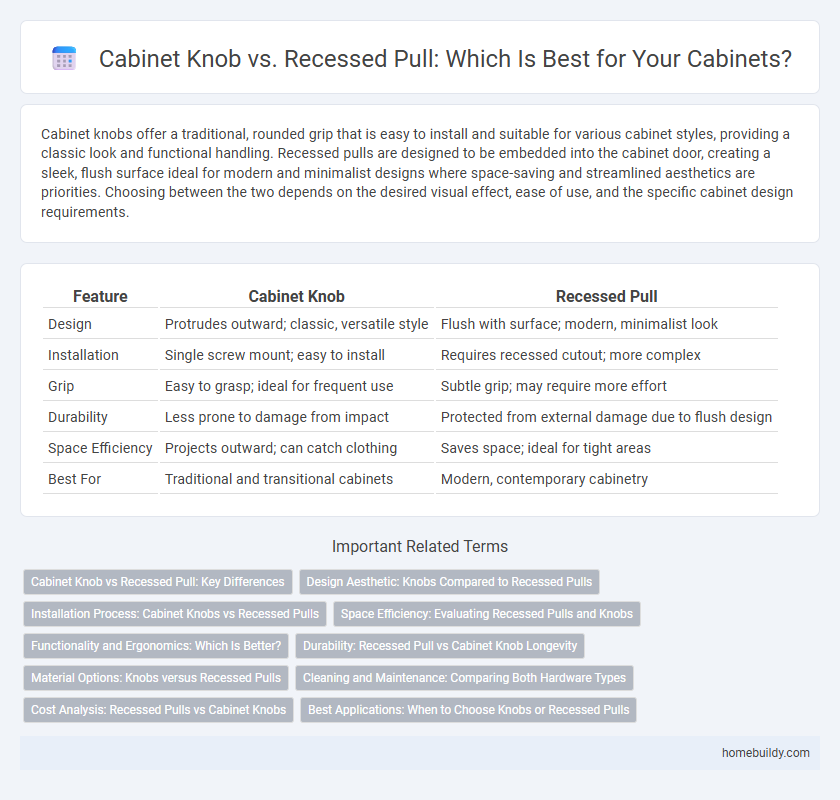Cabinet knobs offer a traditional, rounded grip that is easy to install and suitable for various cabinet styles, providing a classic look and functional handling. Recessed pulls are designed to be embedded into the cabinet door, creating a sleek, flush surface ideal for modern and minimalist designs where space-saving and streamlined aesthetics are priorities. Choosing between the two depends on the desired visual effect, ease of use, and the specific cabinet design requirements.
Table of Comparison
| Feature | Cabinet Knob | Recessed Pull |
|---|---|---|
| Design | Protrudes outward; classic, versatile style | Flush with surface; modern, minimalist look |
| Installation | Single screw mount; easy to install | Requires recessed cutout; more complex |
| Grip | Easy to grasp; ideal for frequent use | Subtle grip; may require more effort |
| Durability | Less prone to damage from impact | Protected from external damage due to flush design |
| Space Efficiency | Projects outward; can catch clothing | Saves space; ideal for tight areas |
| Best For | Traditional and transitional cabinets | Modern, contemporary cabinetry |
Cabinet Knob vs Recessed Pull: Key Differences
Cabinet knobs are small, rounded handles that protrude from the cabinet door, offering a traditional grip and aesthetic, while recessed pulls are built into the cabinet surface, providing a sleek, flush appearance ideal for minimalist designs. Knobs require less precision for installation and are easier to grasp, making them suitable for various furniture styles, whereas recessed pulls enhance modern cabinetry with a streamlined look but may be less accessible. The choice between cabinet knob vs recessed pull depends on the desired style, ergonomics, and ease of use in the kitchen or furniture design.
Design Aesthetic: Knobs Compared to Recessed Pulls
Cabinet knobs offer a classic and versatile design aesthetic that complements various interior styles, from traditional to modern. Unlike recessed pulls, knobs protrude from the cabinet surface, creating a more tactile and visually prominent detail that can enhance the cabinet's overall look. Recessed pulls provide a sleek, minimalist appearance by sitting flush with the cabinet door, making knobs a preferred choice for adding texture and decorative interest.
Installation Process: Cabinet Knobs vs Recessed Pulls
Cabinet knobs require simple installation, typically involving a single screw that attaches the knob directly to the cabinet door or drawer front, making them easy to replace or upgrade. Recessed pulls demand a more complex installation process, often necessitating precise measurement and routing of a cavity into the cabinet surface to fit the pull flush. This difference in installation complexity impacts time, tools needed, and potential damage risk to the cabinet.
Space Efficiency: Evaluating Recessed Pulls and Knobs
Recessed pulls excel in space efficiency by sitting flush with cabinet surfaces, minimizing protrusion and making them ideal for tight or narrow areas. Cabinet knobs, while easier to grasp, extend outward and can reduce usable space, potentially causing obstruction in compact kitchens or furniture. Choosing recessed pulls enhances streamlined design and maximizes room functionality in small or crowded environments.
Functionality and Ergonomics: Which Is Better?
Cabinet knobs offer simple, versatile functionality by allowing easy gripping and quick access, making them ideal for small or frequently used drawers. Recessed pulls provide a sleek, flush design that enhances ergonomics by preventing snagging and offering a comfortable grip for larger cabinets or sliding doors. Choosing between the two depends on the user's preference for tactile ease versus minimalist aesthetics and space-saving ergonomics.
Durability: Recessed Pull vs Cabinet Knob Longevity
Cabinet knobs typically offer robust durability due to their solid metal construction and minimal moving parts, making them resistant to wear over time. Recessed pulls, while sleek and space-saving, often feature integrated mechanisms or thinner materials that may be more prone to damage or wear under frequent use. Longevity tends to favor cabinet knobs in high-traffic areas because their design supports sustained functionality without compromising structural integrity.
Material Options: Knobs versus Recessed Pulls
Cabinet knobs offer diverse material options including metals like brass, stainless steel, and bronze, as well as ceramics and glass, which provide tactile and visual variety. Recessed pulls typically utilize sturdy metals such as aluminum or steel to ensure durability and a sleek, flush appearance ideal for modern cabinetry. The choice between knobs and recessed pulls hinges on both the material aesthetic preferences and the functional demands of the cabinetry.
Cleaning and Maintenance: Comparing Both Hardware Types
Cabinet knobs offer a simpler cleaning process due to their exposed design, allowing easy access to wipe dirt and grime without intricate crevices. Recessed pulls, often set flush with the cabinet surface, can accumulate dust and debris in their grooves, requiring more detailed maintenance and tools like small brushes for thorough cleaning. Choosing between the two depends on preference for ease of maintenance versus sleek aesthetic integration in cabinetry.
Cost Analysis: Recessed Pulls vs Cabinet Knobs
Cabinet knobs generally cost less than recessed pulls, making them a budget-friendly option for kitchen or furniture upgrades. Recessed pulls often require more complex installation and precise measurements, which can increase labor costs compared to the straightforward mounting of cabinet knobs. The price difference on materials and installation should be considered alongside design preferences and functionality to determine the best fit for specific projects.
Best Applications: When to Choose Knobs or Recessed Pulls
Cabinet knobs are best suited for traditional or classic cabinetry where a simple, decorative element is desired, offering easy grip and installation on doors and drawers. Recessed pulls excel in modern or minimalist designs, providing a sleek, flush surface that prevents snagging in tight spaces or high-traffic areas. Choose knobs for aesthetic versatility and tactile ease, while recessed pulls are ideal for streamlined functionality and space-saving applications.
cabinet knob vs recessed pull Infographic

 homebuildy.com
homebuildy.com